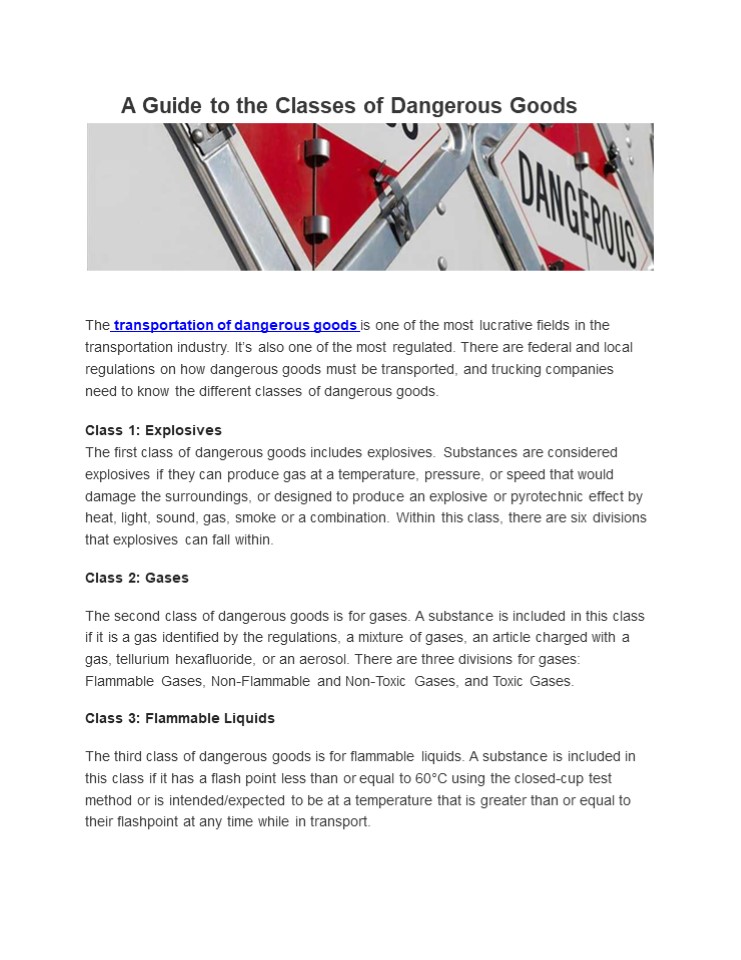A Guide to the Classes of Dangerous Goods - PowerPoint PPT Presentation
Title:
A Guide to the Classes of Dangerous Goods
Description:
The transportation of dangerous goods is one of the most lucrative fields in the transportation industry. It’s also one of the most regulated. There are federal and local regulations on how dangerous goods must be transported, and trucking companies need to know the different classes of dangerous goods. If you want to learn more about the transportation of dangerous goods, sign up for our Transportation of Dangerous Goods course. You’ll learn all about relevant regulations, the different classes, necessary documentation, and emergency response plans. – PowerPoint PPT presentation
Number of Views:0
Title: A Guide to the Classes of Dangerous Goods
1
A Guide to the Classes of Dangerous Goods
The transportation of dangerous goods is one of
the most lucrative fields in the transportation
industry. Its also one of the most regulated.
There are federal and local regulations on how
dangerous goods must be transported, and trucking
companies need to know the different classes of
dangerous goods. Class 1 Explosives The first
class of dangerous goods includes explosives.
Substances are considered explosives if they can
produce gas at a temperature, pressure, or speed
that would damage the surroundings, or designed
to produce an explosive or pyrotechnic effect by
heat, light, sound, gas, smoke or a combination.
Within this class, there are six divisions that
explosives can fall within. Class 2 Gases The
second class of dangerous goods is for gases. A
substance is included in this class if it is a
gas identified by the regulations, a mixture of
gases, an article charged with a gas, tellurium
hexafluoride, or an aerosol. There are three
divisions for gases Flammable Gases,
Non-Flammable and Non-Toxic Gases, and Toxic
Gases. Class 3 Flammable Liquids The third class
of dangerous goods is for flammable liquids. A
substance is included in this class if it has a
flash point less than or equal to 60C using the
closed-cup test method or is intended/expected to
be at a temperature that is greater than or equal
to their flashpoint at any time while in
transport.
2
Class 4 Flammable Solids
The fourth class of dangerous goods includes
flammable solids, substances liable to
spontaneous combustion, and water-reactive
substances. There are three divisions for this
class Flammable Solids, Substances Liable to
Spontaneous Combustion, and Water-reactive
substances. Class 5 Oxidizing Substances and
Organic Peroxides The fifth class of dangerous
goods includes oxidizing substances and organic
peroxides. Oxidizing substances are that which
yields oxygen that causes or contributes to the
combustion of other materials. Class 6 Toxic and
Infectious Substances The sixth class of
dangerous goods is for toxic and infectious
substances. Substances are included in this class
if they are liable to cause death, serious
injury, or harm human health or an infectious
substance. Class 7 Radioactive Materials The
seventh class of dangerous materials includes
radioactive materials. This class is heavily
regulated and dangerous. Class 8 Corrosives The
eighth class of dangerous materials includes
corrosives. Substances are included in this class
if they are known to cause the destruction of
human skin or exhibit a corrosive rate exceeding
6.25 mm per year. Class 9 Miscellaneous
Products, Substances, and Organisms The ninth
class of dangerous goods is for any substance
that is explicitly stated in regulations or does
not meet the criteria for any inclusion in any of
the other classes.
3
If you want to learn more about the
transportation of dangerous goods, sign up for
our Transportation of Dangerous Goods course.
Youll learn all about relevant regulations, the
different classes, necessary documentation, and
emergency response plans.






![⚡[PDF]✔ Randall's Rules Volume One: The Definitive Guide For Successfully Navigating PowerPoint PPT Presentation](https://s3.amazonaws.com/images.powershow.com/10063907.th0.jpg?_=20240625080)
























